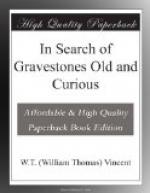[Footnote 5: Weever’s “Funeral Monuments,” A.D. 1631.]
And there was a danger to be encountered far later than that which was due to the anti-Popery zealots of the Tudor dynasty. On the introduction of the Commonwealth there arose such a crusade against all forms and emblems of doctrinal import as to affect not only the ornaments of the churches, but the gravestones in the churchyards, many of which were removed and put to other uses or sold. The Puritans, as is well known, went to the extremity of abolishing all ceremony whatever at the Burial of the Dead.[6] The beautiful Service in the Book of Common Prayer, now used more or less by all the Reformed Christian denominations of England, was abolished by Parliament in 1645—that and the Prayer Book together at one stroke. In lieu of the Prayer Book a “Directory” was issued on the conduct of public worship, in which it was said:
[Footnote 6: There does not appear to have been any form of prayer for the dead prior to the issue of Gaskell’s “Prymer” in 1400. The Service now in use dates from 1611.]
“Concerning Burial of the Dead, all customs of praying, reading, and singing, both in going to or from the grave, are said to have been greatly abused. The simple direction is therefore given, that when any person departeth this life, let the body upon the day of burial be decently attended from the house to the place appointed for public burial, and there immediately interred without any ceremony.”
Penalties were at the same time imposed for using the Book of Common Prayer in any place of worship or in any private family within the kingdom—the fine being L5 for a first offence, L10 for a second, and a year’s imprisonment for the third.
The Puritans, however, are to be thanked for stopping the then common practice of holding wakes and fairs in the churchyards—a practice traceable no doubt to the celebration of Saints’ Days in the churches, and for that reason suppressed as remnants of Popery in 1627-31.
It need not be said that the Burial Service and the Prayer Book came back with the Restoration, but the discontinuance of fairs in churchyards seems to have been permanent. Many instances, however, have occurred in later years of desecration by pasturing cattle in the churchyards,[7] and offences of this nature have been so recent that the practice cannot be said with confidence to have even now entirely ceased. But we return to the gravestones.
[Footnote 7: At the Archbishop’s Court at Colchester in 1540 it was reported that at a certain church “the hogs root up the graves and beasts lie in the porch.”]
From one cause or another it is pretty certain that for every old gravestone now to be seen twenty or more have disappeared.




